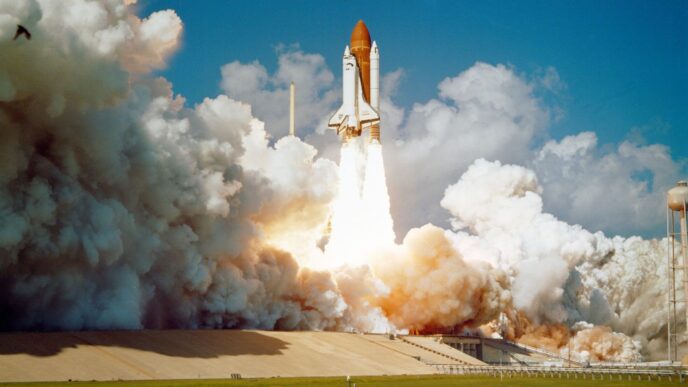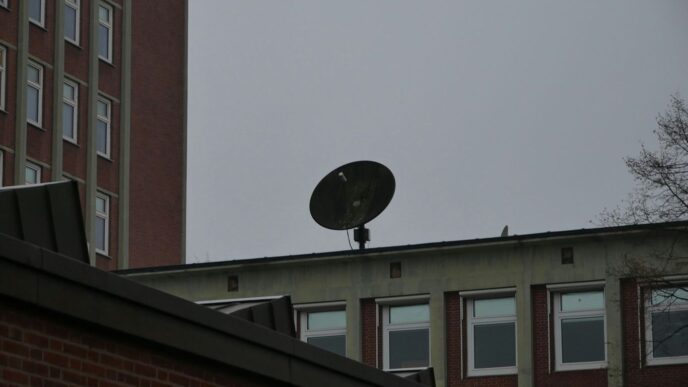Understanding The Origins Of GPS vs BeiDou
The United States’ Global Positioning System
So, let’s talk about GPS. You probably use it every day without even thinking about it, right? It’s that system developed by the U.S. Department of Defense. The first satellite went up way back in 1978, and it took a while, but it was fully up and running by 1995. Initially, it was all about military stuff, but it didn’t take long for everyone else to start using it for, well, everything. Think about your phone’s map app, or how farmers use it to plant crops more precisely. It’s become a pretty standard part of modern life.
China’s BeiDou Navigation Satellite System
Now, China has its own system called BeiDou, or BDS. This one is a bit newer to the global scene. They launched their first satellite in 2000, and it’s been a work in progress. They actually went through a few phases, starting with a regional system and then building up to the global BeiDou-3 system, which became fully operational in 2020. Unlike GPS, which started with a military focus and then opened up, BeiDou was designed from the get-go to serve both military and civilian needs, with an initial strong focus on the Asia-Pacific region before going global. It’s interesting to see how different countries approach these big infrastructure projects.
Comparing Satellite Constellations And Global Coverage
GPS Constellation Design
The United States’ GPS system is built around a constellation of satellites orbiting the Earth in Medium Earth Orbit (MEO). Currently, it consists of over 30 operational satellites spread across six different orbital planes. This arrangement is designed to ensure that at least four satellites are visible from almost any point on the globe at any given time. This redundancy is key to providing continuous positioning services.
BeiDou’s Orbital Mechanics
China’s BeiDou system takes a more complex approach to its orbital mechanics. Unlike GPS, BeiDou utilizes a mix of satellites in different orbits: Geostationary Earth Orbit (GEO), Inclined Geosynchronous Orbit (IGSO), and Medium Earth Orbit (MEO). The GEO and IGSO satellites are positioned in higher orbits and are particularly useful for providing better coverage and signal strength in the Asia-Pacific region. The MEO satellites provide the global coverage.
Global Reach Of Both Systems
Both GPS and BeiDou now offer global coverage, a significant evolution for BeiDou which started as a regional system. However, there are nuances. GPS has a long-established global presence and is deeply integrated worldwide. BeiDou, especially with its BeiDou-3 iteration, has rapidly expanded its reach. Its unique orbital configuration, with those higher-orbiting GEO and IGSO satellites, can sometimes offer advantages in specific regions, particularly in Asia, by providing stronger signals.
Here’s a quick look at their satellite numbers:
| System | Approximate Number of Satellites | Orbital Types Used | Primary Coverage |
|---|---|---|---|
| GPS | 31+ | MEO | Global |
| BeiDou | 35+ | MEO, IGSO, GEO | Global |
While both systems cover the globe, the way they achieve it and the specific strengths in certain areas can differ. This means that in some locations, one system might provide a slightly more robust signal than the other, especially if there are obstructions like tall buildings or dense foliage.
Diving Into Accuracy And Service Offerings
So, how well do these systems actually work, and what can you get from them? It’s not just about knowing where you are, but how precisely and what extra features come along for the ride.
GPS Standard And Precise Services
For a long time, GPS has been the go-to for most people. It offers a standard service that’s pretty good for everyday stuff like using your phone’s map app or finding your way on a road trip. This is the "Standard Positioning Service" (SPS) that most of us use without even thinking about it. But if you need more accuracy, like for surveying or certain scientific work, GPS has "Precise Positioning Service" (PPS). This one is usually reserved for military use, but it’s the backbone of why GPS can be so accurate when needed.
BeiDou’s Open And Restricted Services
BeiDou, on the other hand, has a slightly different approach. It has an "Open Service" that’s available to everyone, much like GPS’s SPS. This is what most commercial applications and regular users will interact with. Then there are "Restricted Services" (RS) and other authorized services. These are for specific users, often government or military, and can provide higher levels of accuracy or specialized functions. One unique thing BeiDou offers is a short message service, which is pretty neat for areas with no cell signal.
Accuracy Metrics For GPS vs BeiDou
When we talk about accuracy, it gets a bit technical, but here’s the gist. Generally, for the open services most people use:
- GPS: Typically offers horizontal accuracy in the range of a few meters. With good conditions and a clear view of the sky, it’s usually reliable for most consumer needs.
- BeiDou: Also provides good accuracy, often around 10 meters globally and potentially better, like 5 meters, in its primary regions. Like GPS, its accuracy can be improved with extra help.
It’s important to remember that these numbers can change based on a lot of factors: the number of satellites visible, atmospheric conditions, and even the type of receiver you’re using. Both systems are constantly being updated, and their accuracy is always improving. For really high-precision needs, both GPS and BeiDou can work with augmentation systems (which we’ll talk about next) to get down to centimeter-level accuracy. It’s not just about the satellites themselves, but how they work with other tech.
Signal Structures And Technical Differences
GPS Signal Frequencies And Technology
GPS has been around for a while, and its signal structure is pretty well-established. It primarily uses a single frequency band for its civilian signal, the L1 band. This signal carries the navigation message and timing information. While this has served us well for decades, it can sometimes be a bit more susceptible to interference or signal blockage, especially in urban canyons or mountainous areas. Think of it like trying to have a conversation in a crowded room using just one voice – it can get a little muddled.
BeiDou’s Dual-Frequency Approach
BeiDou, on the other hand, takes a different tack. It’s designed from the ground up to use multiple frequencies for its signals, notably L1 and L5. This dual-frequency capability is a big deal. It allows receivers to correct for certain types of errors, like ionospheric delays, much more effectively. This means BeiDou can often offer better accuracy, especially when signals are bouncing off things or passing through different atmospheric layers. It’s like having two people talk at once – if one voice gets drowned out, you can still hear the other.
CDMA Versus Combined Technologies
When it comes to how the signals are structured and transmitted, there are differences too. GPS traditionally uses a Code Division Multiple Access (CDMA) technique for its civilian signals. This allows multiple satellites to transmit on the same frequency without interfering with each other by using unique codes. BeiDou, however, employs a more complex mix. It uses CDMA for some signals but also incorporates other techniques, including different modulation schemes. This allows BeiDou to be more flexible and robust. This multi-frequency and multi-modulation approach is a key technical advantage for BeiDou, contributing to its improved accuracy and resilience.
Here’s a quick look at some of the signal aspects:
- GPS (L1): Primarily uses a single civilian frequency (L1) with a specific modulation.
- BeiDou (BDS-3): Utilizes multiple frequencies (e.g., L1, L5) and a combination of CDMA and other advanced signal processing techniques.
- Benefits of BeiDou’s approach: Improved accuracy, better resistance to interference, and enhanced reliability in challenging environments.
Augmentation Systems Enhancing Navigation
Even the best satellite systems can sometimes use a little help, especially when you need super precise location data or when signals get tricky. That’s where augmentation systems come in. Think of them as boosters for GPS and BeiDou, making them even better at their jobs.
GPS Augmentation Networks
For GPS, there are a few ways to boost its performance. The most common ones are ground-based augmentation systems. These systems use a network of ground stations that know their exact location. They monitor GPS signals, figure out any errors, and then send correction data to receivers nearby. This can significantly improve accuracy, sometimes down to just a few centimeters!
- WAAS (Wide Area Augmentation System): This is a big one for North America. It helps aircraft navigate more precisely and also benefits civilian users.
- EGNOS (European Geostationary Navigation Overlay Service): Europe’s version of WAAS, providing similar accuracy improvements.
- SBAS (Satellite-Based Augmentation System): This is the general term for systems like WAAS and EGNOS, which use geostationary satellites to broadcast corrections. These systems are vital for applications where even small errors can have big consequences.
BeiDou’s Ground and Satellite Augmentation
BeiDou also has its own set of augmentation strategies, often built into its design from the start. Because BeiDou is designed to be more than just a global system, it has some unique approaches.
- Regional Augmentation: BeiDou can work with regional systems, like Japan’s QZSS or China’s own domestic enhancements, to provide better coverage and accuracy in specific areas. This is super helpful in places with tall buildings or mountains that can block satellite signals.
- Dual-Frequency Signals: While not strictly an augmentation system, BeiDou’s use of multiple frequencies helps receivers correct for ionospheric errors, a common source of inaccuracy. This is a built-in advantage.
- Ground Stations: Like GPS, BeiDou relies on a network of ground stations to monitor its satellites and broadcast correction data, especially for its more precise services.
These augmentation systems are what allow both GPS and BeiDou to move beyond just general location finding and into highly specialized fields like precision agriculture, autonomous driving, and advanced surveying. They are the unsung heroes making satellite navigation more reliable and accurate than ever before.
Applications And Global Adoption Trends
Widespread GPS Integration
GPS has been around for a while, and honestly, it’s pretty much everywhere. Think about it: your phone uses it for maps, cars have built-in navigation, and even farmers use it to make sure their tractors plant seeds exactly where they should. It’s become this background thing we just expect to work, whether we’re trying to find a new restaurant or coordinating a search and rescue mission. Its integration is so deep that it’s hard to imagine modern life without it. It’s not just for getting from point A to point B, either. Businesses rely on its precise timing for everything from financial transactions to keeping power grids stable. It’s become a backbone for so many critical systems.
BeiDou’s Growing Commercial Footprint
China’s BeiDou system is really making a name for itself, especially in commercial areas. It’s not just a domestic thing anymore; it’s being adopted globally. You’re seeing it pop up in smart transportation systems, helping to manage traffic and logistics more efficiently. It’s also being used for things like monitoring structures for any signs of stress or movement, which is pretty neat. And in emergencies, it can provide quick location data. BeiDou is even offering services like short message communication, which is a bit different from what GPS typically does. This expansion shows it’s becoming a serious player in the global navigation market, challenging the status quo.
Strategic Importance In Various Sectors
Both GPS and BeiDou are more than just navigation tools; they’re becoming strategically important. For militaries, they’re key for navigation, tracking, and even guiding precision weapons. The US military has long relied on GPS, and now other countries are looking at BeiDou for similar capabilities. It’s not just about defense, though. Think about telecommunications and financial networks – they depend on the accurate timing signals from these satellite systems. BeiDou, in particular, is being integrated into China’s national infrastructure, which gives it a significant advantage in areas like transportation and disaster management. This makes the competition between these systems about more than just technology; it’s about global influence and control over critical infrastructure.
The Global Competition Landscape
BeiDou As A Technical Challenger
It’s pretty clear that China’s BeiDou system isn’t just playing catch-up anymore; it’s actively stepping into the ring as a serious contender against the long-standing GPS. Reports suggest BeiDou is not only packing more satellites over various regions but also showing off some impressive accuracy that can even edge out GPS in certain spots. Some folks in the know, even within advisory panels for GPS, have noted that BeiDou is technically pulling ahead in some areas. This isn’t just about having another option for finding your way; it’s becoming a significant part of how countries assert their technological and economic influence globally.
Geopolitical Implications Of Navigation Dominance
This competition goes way beyond just who has the better satellite signal. It’s about national power and influence in the 21st century. When a country like China exports its technology, including BeiDou, as part of larger initiatives like the Belt and Road, it creates dependencies. The US, for instance, is being urged to think more broadly about this, recognizing that leaving a void in the developing world allows competitors to step in. The fear is that if Western nations don’t offer competitive, integrated tech solutions, they risk ceding control of global infrastructure. It’s a complex game where technological leadership directly ties into economic strength and geopolitical standing. The future of how we all navigate, from our phones to critical infrastructure, is being shaped by this ongoing rivalry.
Wrapping It Up
So, we’ve looked at GPS and BeiDou, two big players in getting us from here to there. GPS has been around for ages, like the old reliable friend everyone knows. But BeiDou, China’s system, is really stepping up, bringing its own set of features and a growing global presence. It’s not just about which one is ‘better’ anymore; it’s more about how these systems work together, or sometimes compete, to keep us all connected and moving. As technology keeps changing, we’ll likely see both GPS and BeiDou continue to evolve, maybe even finding new ways to work side-by-side. It’s pretty interesting to see how these satellite networks shape our world, from our phones to bigger stuff like shipping and farming.












